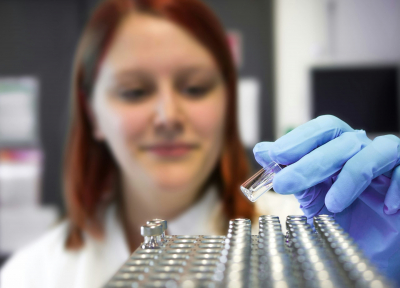Pathogens
Explore the different types of infectious agents that cause disease.
On This Page:
Overview
Pathogens are foreign invaders to the body that cause disease. They can cause illnesses like common colds, stomach bugs, tickborne illnesses, sexually transmitted infections — and almost anything else that you can catch from other people or the environment around you. While the role of the immune system is to protect against pathogens, sometimes they sneak past or overwhelm the immune system, which gives the pathogen the opportunity to make you sick. When this happens, the immune system works hard to defeat the pathogen and rid your body of it. The good news is that the adaptive immune system can remember pathogens and be better prepared to fight them on later encounters.
Key Points
- Pathogens or germs are foreign invaders, such as viruses, bacteria, fungi, or parasites, that cause disease.
- One of the roles of the immune system is to prevent pathogens from invading and fight them off when they do.
Bacteria
Bacteria are microscopic living organisms made of only one cell. There are millions of different types of bacteria that can be found in the environment, on surfaces, and even in your body. Not all bacteria cause disease, and some can even be beneficial, however bacteria that do cause disease are pathogens. Neutrophils, lymphocytes, and macrophages are some of the immune cells that play a role in fighting bacteria that cause disease. Some common bacteria that cause disease are:
- Streptococcus: the cause of strep throat
- Staphylococcus: the cause of staph infection
- Escherichia coli: the cause of E.coli infections such as in food poisoning
Viruses
A virus is a microscopic infectious agent that consists of genetic material, either DNA or RNA, encased in a shell. Viruses are not considered living as they cannot survive on their own. Instead they rely on a host, like a person or animal, to replicate. To infect your cells, viruses often enter the body through mucus membranes such as those found in the nose, lungs and digestive tract. They then attach to one of your cells and use that cell to replicate the virus’s genetic material. The infected cell then assembles and releases more copies of that virus into the body. Since viruses rely on your cells to replicate, they often have sneaky ways of evading detection by your immune system. Cytotoxic T cells and natural killer cells are some of the immune cells that play a large role in killing viruses. Some common viruses that cause disease are:
- Influenza virus – causes the flu
- Human immunodeficiency virus (HIV) – the cause of HIV and AIDS
- Varicella-zoster virus – causes chickenpox
- Human papilloma virus – the cause of HPV infection which can lead to some cancers
Fungi
There are millions of fungi in the world, including the mushrooms you eat. Only a small number of fungi are known to cause disease, but when they do they are pathogens. Fungal infection, also known as mycosis, is typically caused by yeasts or molds. Fungal infections are most common on your skin or nails, but fungi can also cause infections in your mouth, throat, lungs, urinary tract and many other parts of your body. Dendritic cells and macrophages are some of the immune cells that identify fungal infections helping to flag and remove the infection. Some groups of fungi that cause infection in humans are:
- Dermatophytes – cause of ringworm and athlete’s foot
- Candida – causes candidiasis or yeast infections throughout the body such as vaginal yeast infection, urinary tract infection, and skin infections
Parasites
Parasites are organisms that live in, on or with another organism: their host. When living with the host, parasites eat, grow, and multiply in ways that harm the host. Parasites themselves can cause disease, or they can carry diseases that transfer to the host and cause illness. There are three main categories of parasites: ectoparasites, helminths, and protozoans. Depending on the type of parasite, many different immune cells and signals are involved in identifying parasites, activating immune responses at the site of infection, and destroying parasites.
Ectoparasites
Ectoparasites remain on the outside of the body and attach or burrow into the skin and stay there for weeks to months. This includes ticks, fleas, lice, and mites. Many ectoparasites are vectors, which means they carry diseases, like bacteria or viruses, that they pass to the host when they attach. An example of this is Lyme Disease, which is caused by a bacteria carried by ticks.
Helminth
Helminths are large parasites that in their adult form can be seen without a microscope. Not all helminths are parasitic. Helminths that cause disease are often called parasitic worms. The types of helminths that affect people are flukes, tapeworms, and roundworms.
Protozoa
Protozoa are microscopic, single-celled organisms, different from bacteria, and some are parasitic to people. There are tens of thousands of different types of protozoans and experts classify them according to how they move. Protozoa may infect your intestines, blood, or tissues. They can also spread through contaminated food or water, person-to-person contact, or through the bite of a vector. Malaria is a common disease caused by protozoa.
Sources
- Jain, A., Marshall, J., Buikema, A., Bancroft, T., Kelly, J. P., & Newschaffer, C. J. (2015). Autism Occurrence by MMR Vaccine Status Among US Children With Older Siblings With and Without Autism. JAMA, 313(15), 1534. https://doi.org/10.1001/jama.2015.3077
- Taylor, B., Miller, E., Farrington, Cp., Petropoulos, M.-C., Favot-Mayaud, I., Li, J., & Waight, P. A. (1999). Autism and measles, mumps, and rubella vaccine: no epidemiological evidence for a causal association. The Lancet, 353(9169), 2026–2029. https://doi.org/10.1016/s0140-6736(99)01239-8
- Madsen, K. M., Hviid, A., Vestergaard, M., Schendel, D., Wohlfahrt, J., Thorsen, P., Olsen, J., & Melbye, M. (2002). A Population-Based Study of Measles, Mumps, and Rubella Vaccination and Autism. New England Journal of Medicine, 347(19), 1477–1482. https://doi.org/10.1056/nejmoa021134
Related Topics
Downloads
External Resources
Latest News


